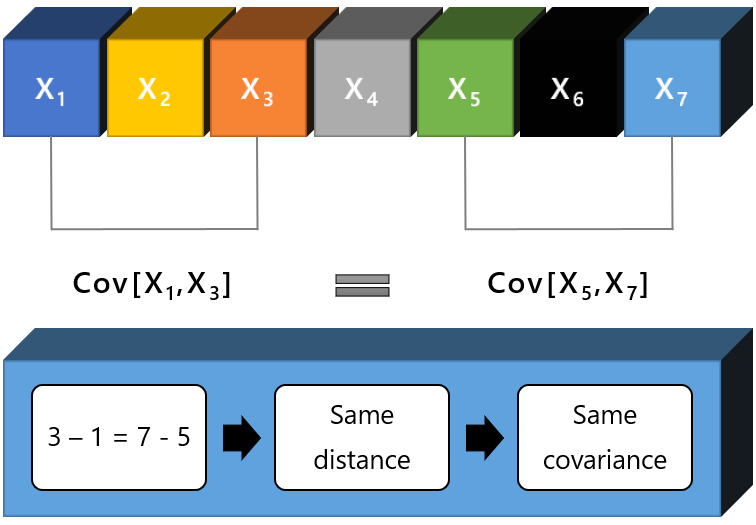A sequence of random variables is covariance stationary if:
all the terms of the sequence have the same mean;
the covariance between any two terms of the sequence depends only on the relative position of the two terms and not on their absolute position.
By relative position of two terms we mean how far apart they are located from each other in the sequence.
Instead, the absolute position refers to where they are located in the sequence.

Covariance stationary sequences are also called:
weakly stationary sequences;
covariance stationary processes;
weakly stationary processes.
Often, we also use the term time series instead of sequence or process.
This is a formal definition.
Definition
A sequence of random variables
is covariance stationary if and only
if
![[eq2]](/images/covariance-stationary__2.png)
In words:
all the terms of the sequence have mean
;
the covariance
depends only on the relative position
and not on the absolute position
.
Note
that![]() which
implies that a weakly stationary process has constant
variance.
which
implies that a weakly stationary process has constant
variance.
The definition above applies without modifications to sequences of random vectors.
In the case of a sequence of vectors,
is a vector of expected values and
is a matrix of covariances between the entries of the two vectors
and
(a cross-covariance matrix).
Let us make some examples.
The simplest example is the so called white noise process, a sequence
that satisfies the following three conditions for any
and
:
where
is a positive constant.
Let
be the white noise process of the previous example.
A first-order autoregressive process is a sequence
whose terms
satisfy
where
is a constant and the recursion starts from a random variable
uncorrelated
with the terms of
.
The expected values
of the terms of the sequence
are![[eq13]](/images/covariance-stationary__23.png)
For the process
to be weakly stationary, the first condition that needs to be satisfied is
![]() which
is satisfied only if
which
is satisfied only if
or
.
The latter possibility wil be ruled out below.
The variances
are![[eq18]](/images/covariance-stationary__28.png)
The variances remain finite as
grows only if
.
Furthermore, the
condition
![]() is
satisfied only
if
is
satisfied only
ifwhich
can be shown, for example, by
solving
![[eq21]](/images/covariance-stationary__33.png)
As proved in the lecture on
autocorrelation,
the covariance between any two terms of the sequence
is![]() which
satisfies the condition stated in the definition of weak stationarity (the
covariance depends only on
which
satisfies the condition stated in the definition of weak stationarity (the
covariance depends only on
).
Thus, the sequence
is covariance stationary only
if
A stronger concept of stationarity is that of strict stationarity.
A sequence
is said to be strictly stationary if and only if
and
have
the same joint distribution for
any
,
and
.
The concept of covariance stationarity is often used in probability, statistics and time-series analysis.
Here are some examples:
it is used to compute the autocorrelation function of a process;
it is used to derive Laws of Large Numbers for correlated sequences.
Other concepts related to covariance stationarity can be found in the lecture on sequences of random variables.
Previous entry: Covariance formula
Next entry: Critical value
Please cite as:
Taboga, Marco (2021). "Covariance stationary", Lectures on probability theory and mathematical statistics. Kindle Direct Publishing. Online appendix. https://www.statlect.com/glossary/covariance-stationary.
Most of the learning materials found on this website are now available in a traditional textbook format.